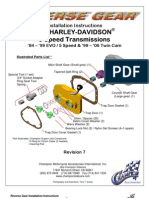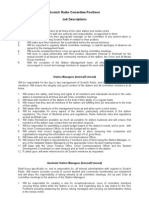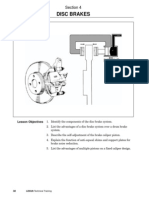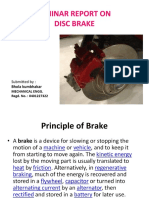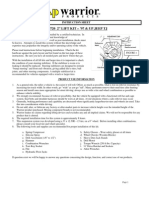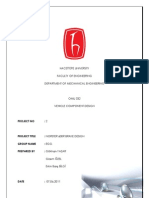206-04 Rear Disc Brake
206-04 Rear Disc Brake
Uploaded by
Miguel AngelCopyright:
Available Formats
206-04 Rear Disc Brake
206-04 Rear Disc Brake
Uploaded by
Miguel AngelOriginal Description:
Copyright
Available Formats
Share this document
Did you find this document useful?
Is this content inappropriate?
Copyright:
Available Formats
206-04 Rear Disc Brake
206-04 Rear Disc Brake
Uploaded by
Miguel AngelCopyright:
Available Formats
http://topix.landrover.jlrext.com/topix/service/procedure/146634/OD...
Published: 11-May-2011
Rear Disc Brake General Specification
Item
Rear disc:
3.2 Petrol engine
2.2 Diesel engine
Rear disc diameter:
Ventilated
Solid
Rear disc thickness new:
Ventilated
Solid
Service limit:
Ventilated
Solid
Pad minimum thickness
Maximum disc run out - Disc installed
Specification
Ventilated
Solid
302 mm (11.9 in)
302 mm (11.9 in)
20 mm (0.79 in)
12 mm (0.47 in)
18 mm
10 mm
2 mm
0.080 mm
Torque Specifications
Description
Brake caliper bleed screw
Brake caliper fixed carrier to wheel knuckle bolts*
Brake caliper guide pin bolts
Brake disc dust shield bolts
Brake disc Torx screw
Brake flexi hose unions to caliper
Brake hose retaining bracket to wheel knuckle bolt
* New nuts/bolts must be installed
1 of 1
Nm
10
110
30
13
35
15
22
lb-ft
7
81
22
10
26
11
16
23/02/2012 10:51 AM
http://topix.landrover.jlrext.com/topix/service/procedure/146634/OD...
Published: 11-May-2011
Part Number
-
Rear Disc Brake - Rear Disc Brake
Description and Operation
COMPONENT LOCATION
1 of 4
Item
Part Number
Description
Anti-lock Brake System (ABS) sensor cable
Flexible hose
23/02/2012 10:51 AM
http://topix.landrover.jlrext.com/topix/service/procedure/146634/OD...
Dust shield
Parking brake assembly
Dust shield retaining screw (4 off)
Brake disc solid (TD4 diesel vehicle)
Brake disc retaining screw
Brake disc ventilated (i6 gasoline vehicle)
Fixed carrier
10
Bushed bolt rubber boot (2 off)
11
Bushed bolt
12
Caliper piston seal
13
Brake pad retaining spring (2 off)
14
Outer anti-squeal shim
15
Caliper piston
16
Outer brake pad
17
Inner brake pad
18
Sliding caliper
19
Inner anti-squeal shim
20
Caliper bleed screw
21
Bleed screw cap
22
Bushed bolt retaining screw (2 off)
23
Rear Left-Hand (LH) wheel knuckle
24
Fixed carrier retaining bolt (2 off)
25
Anti-lock Brake System (ABS) sensor retaining screw
OVERVIEW
The rear brake assembly features either a conventional ventilated or a solid type brake disc, and cast-iron sliding caliper with
single acting piston.
BRAKE DISC
2 of 4
23/02/2012 10:51 AM
http://topix.landrover.jlrext.com/topix/service/procedure/146634/OD...
Item
Description
Rear brake disc - i6 gasoline vehicle
Rear brake disc - TD4 diesel vehicle
The ventilated type brake disc is 302 x 20 mm (11.89 x 0.79 in) in diameter and installed to the 3.2 liter i6 gasoline vehicle.
The solid type brake disc is 302 x 12 mm (11.89 x 0.47 in) in diameter and installed to the 2.2 liter TD4 diesel vehicle. The
brake disc is secured to the wheel knuckle hub with a single screw and is also retained by the 5 wheel securing nuts.
Both sizes of rear brake disc are sufficiently cooled to achieve high levels of thermal stability, even during severe braking.
The solid type brake disc is cooled as the vehicles forward motion directs air over the disc surfaces. The conventional
ventilated disc is cooled by the forward motion of the vehicle drawing air through radial slots formed on the disc outer rim.
The air cools the disc from the inside edge to the disc center, before venting out through slots formed around the disc central
bell.
The brake disc also forms the location for the parking brake components. The brake disc internal diameter is 185 mm (7.28
in) and is machined with a smooth surface to form the brake drum. An integral backplate and brake dust shield is mounted to
the rear of the brake disc. The backplate encloses the brake disc and also provides the mounting location for the 2 parking
brake shoes and operating components.
An aperture is formed in the dust shield and backplate that allows the parking brake cable to protrude through to the inner
side of the brake disc, and connect to the parking brake expander unit. A hole machined in the brake disc outer hub provides
access to the parking brake manual adjuster.
For additional information, refer to: Parking Brake (206-05 Parking Brake and Actuation, Description and Operation).
CALIPER ASSEMBLY
Item
Description
Rear brake caliper - i6 gasoline vehicle
Rear brake caliper - TD4 diesel vehicle
The caliper assembly comprises a fixed carrier and sliding caliper. The fixed carrier is mounted to straddle the brake disc and
is attached to the wheel knuckle with 2 bolts. The fixed carrier provides the location for 2 brake pads that are mounted on
either side of the brake disc, and is formed with guide channels that allow the brake pads to slide toward the disc surface.
NOTE: The 2 fixed carrier retaining bolts are pre-applied with a thread locking adhesive and must not be re-used during
maintenance. New fixed carrier retaining bolts must be used and the original bolts discarded.
The sliding caliper is mounted over the fixed carrier and retains the 2 brake pads within the caliper assembly. The sliding
caliper is secured to the fixed carrier with 2 bushed bolts, and is formed with a hydraulic chamber containing a piston and
annular seal.
3 of 4
23/02/2012 10:51 AM
http://topix.landrover.jlrext.com/topix/service/procedure/146634/OD...
The sliding caliper is connected via a flexible hose to the brake system hydraulic circuit, and also incorporates a bleed screw
for maintenance purposes.
The 2 bushed bolts are machined with a smooth surface and are protected from dirt and moisture ingress with a collapsible
rubber boot. The bushed bolts allow the sliding caliper limited lateral movement along the fixed carrier.
An anti-squeal shim is installed on the outside edge of each brake pad and reduces Noise, Vibration and Harshness (NVH)
from the brake components during operation.
An upper and lower brake pad retaining spring are mounted between the fixed carrier and sliding caliper. The retaining
springs are held in position by the 2 bushed bolts, and maintain pressure on the brake pads to prevent radial movement of
the pads away from the brake disc.
The brake pads are not installed with pad wear sensors.
BRAKE DUST SHIELD
A formed brake dust shield and integral parking brake backplate is located between the wheel knuckle and brake disc, and is
secured to the knuckle with 4 screws.
The brake dust shield is handed to the relevant side of the vehicle and protects the brake components from cross axle stone
throws. The brake dust shield also prevents debris and brake dust from spreading to other parts of the vehicle.
PRINCIPLES OF OPERATION
Brake Application
As the brake pedal is applied, initial hydraulic pressure is felt in the sliding caliper chamber causing the piston to extend
toward the brake disc. The moving piston contacts the inner brake pad, forcing the pad along the fixed carrier guide channels
and into contact with the inner side of the brake disc.
As the piston extends from the caliper chamber, it passes through an internal annular seal located within the caliper chamber.
The movement of the piston distorts the shape of the seal and consequently, the seal applies pressure on the piston outer
surface.
The sliding caliper now reacts and commences to slide along the 2 bushed bolts, in the opposite direction to the extending
piston. The sliding caliper contacts the outer brake pad, forcing the pad along the fixed carrier guide channels and into
contact with the outer side of the brake disc.
With both brake pads now in full contact with the brake disc and hydraulic pressure acting on the piston, no further
movement of the piston and sliding caliper is possible. The force created by the piston and caliper acting against the brake
pads increases rapidly, trapping the brake disc and slowing the vehicle.
Brake Release
As the brake pedal is released, hydraulic pressure in the caliper chamber collapses and force is no longer applied to the brake
pads. The brake pads are moved slightly outwards by the action of the rotating brake disc, and the caliper internal annular
seal returns to the normal shape. As the seal moves it grips on the piston outer surface and withdraws the piston into the
chamber, sufficiently to provide the necessary pad to disc clearance.
This action prevents the piston from holding the inner brake pad against the disc, and also enables the piston to protrude
further from the caliper chamber to compensate for brake pad wear.
4 of 4
23/02/2012 10:51 AM
http://topix.landrover.jlrext.com/topix/service/procedure/146634/OD...
Published: 11-May-2011
Rear Disc Brake - Rear Disc Brake
Diagnosis and Testing
For additional information.
REFER to: Brake System (206-00 Brake System - General Information, Diagnosis and Testing).
1 of 1
23/02/2012 10:51 AM
http://topix.landrover.jlrext.com/topix/service/procedure/146634/OD...
Published: 11-May-2011
Rear Disc Brake - Brake Pads
Removal and Installation
Removal
1.
WARNING: Do not work on or under a vehicle supported only by
a jack. Always support the vehicle on safety stands.
Raise and support the vehicle.
2. Remove the wheel and tire.
Refer to: Wheel and Tire (204-04 Wheels and Tires, Removal and
Installation).
3. Remove the brake caliper lower bolt.
4. Remove the brake pads.
1 of 3
23/02/2012 10:51 AM
http://topix.landrover.jlrext.com/topix/service/procedure/146634/OD...
5. Remove the brake pad clips.
Installation
1.
WARNING: Do not use compressed air to clean brake
components. Dust from friction materials can be harmful if inhaled.
Clean the brake caliper housing and anchor plate using brake cleaning
fluid.
2. Inspect the caliper piston and slide pin seals for damage.
3. Position a bleed jar containing a small quantity of
approved brake fluid. Connect the bleed tube to the
bleed screw and loosen the screw.
4. Press the piston into the caliper housing and tighten the bleed screw.
Torque: 10 Nm
5. Disconnect the bleed tube and remove the jar.
6. CAUTIONS:
If new brake pads are installed, a new gold coloured brake pad
clip must be fitted in the lower position. The clip with one hole must
be fitted to petrol vehicles. The clip with two holes must be fitted to
diesel vehicles. Failure to follow this instruction may result in damage
to the vehicle.
2 of 3
23/02/2012 10:51 AM
http://topix.landrover.jlrext.com/topix/service/procedure/146634/OD...
If new brake pads are installed, a new black coloured brake pad
clip must be fitted in the upper position. Failure to follow this
instruction may result in damage to the vehicle.
Install the brake pad clips.
7. Install the brake pads.
8. Secure the brake caliper.
Torque: 35 Nm
9. Repeat the above procedure for the other side.
10. Install the wheels and tires.
Refer to: Wheel and Tire (204-04 Wheels and Tires, Removal and
Installation).
11. Depress the brake pedal several times, check the fluid level in the
brake fluid reservoir and top-up with brake fluid if necessary.
3 of 3
23/02/2012 10:51 AM
http://topix.landrover.jlrext.com/topix/service/procedure/146634/OD...
Published: 11-May-2011
Rear Disc Brake - Brake Disc
Removal and Installation
Removal
NOTE: If the parking brake shoes or the brake discs have been removed for access to other components then DO NOT carry
out the bedding in procedure.
1.
WARNING: Make sure to support the vehicle with axle stands.
Raise and support the vehicle.
2. Remove the wheels and tires.
Refer to: Wheel and Tire (204-04 Wheels and Tires, Removal and
Installation).
3.
CAUTION: Make sure that no load is placed on the
brake hose.
Tie the brake caliper and anchor aside.
4.
Release the park brake shoe adjustment.
5.
1 of 2
23/02/2012 10:51 AM
http://topix.landrover.jlrext.com/topix/service/procedure/146634/OD...
6. Repeat the above procedure for the other side.
Installation
1.
CAUTION: Make sure that the mating faces are clean and free of
foreign material.
Install the brake disc.
Torque: 35 Nm
2. CAUTIONS:
Make sure that the mating faces are clean and free of foreign
material.
Make sure that the brake hose is not twisted and is correctly
located.
Secure the brake caliper and anchor plate to the wheel knuckle.
Torque: 110 Nm
3. Repeat the above procedure for the other side.
4. Adjust the parking brake.
Refer to: Parking Brake Cable Adjustment (206-05 Parking Brake and
Actuation, General Procedures).
5. Install the wheels and tires.
6. If necessary, carry out the parking brake shoe bedding-in procedure.
Refer to: Parking Brake Shoes Bedding-In (206-05 Parking Brake and
Actuation, General Procedures).
2 of 2
23/02/2012 10:51 AM
http://topix.landrover.jlrext.com/topix/service/procedure/146634/OD...
Published: 11-May-2011
Rear Disc Brake - Brake Caliper
Removal and Installation
Removal
1.
WARNING: Make sure to support the vehicle with axle stands.
Raise and support the vehicle.
2. Remove the wheel and tire.
Refer to: Wheel and Tire (204-04 Wheels and Tires, Removal and
Installation).
3.
CAUTION: Make sure that new bolts are installed.
NOTE: Use an additional wrench to prevent the
component from rotating.
4.
5.
CAUTION: Make sure that new bolts are installed.
NOTE: Use an additional wrench to prevent the
component from rotating.
1 of 3
23/02/2012 10:51 AM
http://topix.landrover.jlrext.com/topix/service/procedure/146634/OD...
6.
CAUTION: Make sure that all openings are sealed.
Use new blanking caps.
7. Remove the brake caliper housing.
Installation
1.
WARNING: Do not use compressed air to clean brake
components. Dust from friction materials can be harmful if inhaled.
Clean the brake caliper housing and anchor plate using brake cleaning
fluid.
2. Install the brake caliper.
3. Connect the brake tube to the brake caliper.
Torque: 30 Nm
4. Install the brake caliper upper bolt.
Torque: 30 Nm
5.
Install the two clips.
Install the brake pads.
6.
CAUTION: Make sure that the brake hose is not twisted and is
correctly located.
Install the brake caliper lower bolt.
Torque: 30 Nm
7. Install the wheel and tire.
Refer to: Wheel and Tire (204-04 Wheels and Tires, Removal and
Installation).
8. Bleed the brake system.
Refer to: Brake System Bleeding (206-00 Brake System - General
Information, General Procedures).
2 of 3
23/02/2012 10:51 AM
http://topix.landrover.jlrext.com/topix/service/procedure/146634/OD...
3 of 3
23/02/2012 10:51 AM
http://topix.landrover.jlrext.com/topix/service/procedure/146634/OD...
Published: 11-May-2011
Rear Disc Brake - Brake Caliper Anchor Plate
Removal and Installation
Removal
1.
WARNING: Make sure to support the vehicle with axle stands.
Raise and support the vehicle.
2. Remove the wheel and tire.
Refer to: Wheel and Tire (204-04 Wheels and Tires, Removal and
Installation).
3.
4.
5.
1 of 3
23/02/2012 10:52 AM
http://topix.landrover.jlrext.com/topix/service/procedure/146634/OD...
6.
CAUTION: Do not allow the brake caliper to hang on the brake
hose.
Tie the brake caliper housing aside.
7.
8.
Installation
1.
WARNING: Do not use compressed air to clean brake
components. Dust from friction materials can be harmful if inhaled.
Clean the brake caliper housing and anchor plate using brake cleaning
fluid.
2. Clean and lubricate the guide pins.
3. Install the guide pins.
4.
CAUTION: Make sure that new bolts are installed.
Install the brake caliper anchor plate.
Torque: 110 Nm
6. Install the clips and brake pads.
CAUTION: Make sure that new bolts are installed.
5.
Install the brake caliper housing and install the top bolt.
7. CAUTIONS:
Torque: 35 Nm
2 of 3
23/02/2012 10:52 AM
http://topix.landrover.jlrext.com/topix/service/procedure/146634/OD...
Make sure that new bolts are installed.
Make sure that the brake hose is not twisted and is correctly
located.
Align the brake caliper to the anchor plate.
Torque: 30 Nm
8. Install the wheel and tire.
Refer to: Wheel and Tire (204-04 Wheels and Tires, Removal and
Installation).
3 of 3
23/02/2012 10:52 AM
You might also like
- Section 2 - Clutch AssemblyDocument29 pagesSection 2 - Clutch Assemblyjsmanian79No ratings yet
- SM Tm3989 Knott A4Document1 pageSM Tm3989 Knott A4Marc GlebNo ratings yet
- Installation Manual Reverse Gear 5 Speed Revision 7Document6 pagesInstallation Manual Reverse Gear 5 Speed Revision 7arieskittenNo ratings yet
- Ford Escort Rear Disc Brake Conversion - 001Document8 pagesFord Escort Rear Disc Brake Conversion - 001910pcsupport100% (1)
- 205-02 Rear Drive Axle DifferentialDocument50 pages205-02 Rear Drive Axle DifferentialMiguel Angel100% (2)
- 211-04 Steering ColumnDocument14 pages211-04 Steering ColumnMiguel AngelNo ratings yet
- Scratch Radio Committee Job Descriptions April 2011Document5 pagesScratch Radio Committee Job Descriptions April 2011benstones1No ratings yet
- Indiana Court of Appeal-Appellant's BriefDocument36 pagesIndiana Court of Appeal-Appellant's BriefKay KimNo ratings yet
- Process Industry Practices Coatings: PIP CTSL1000 Application of Internal LiningsDocument23 pagesProcess Industry Practices Coatings: PIP CTSL1000 Application of Internal LiningsSujita Sah100% (1)
- Ford Manual for Owners and Operators of Ford Cars and Trucks (1919)From EverandFord Manual for Owners and Operators of Ford Cars and Trucks (1919)No ratings yet
- 206-03 Front Disc BrakeDocument13 pages206-03 Front Disc BrakeMiguel AngelNo ratings yet
- To Whom It May ConcernDocument96 pagesTo Whom It May ConcernKamal SharmaNo ratings yet
- 2.experiment No2 SfbaksjfbkajfDocument6 pages2.experiment No2 Sfbaksjfbkajfpratik thakareNo ratings yet
- 204-02 Rear SuspensionDocument44 pages204-02 Rear SuspensionMiguel AngelNo ratings yet
- Suspension Trasera 97-98Document6 pagesSuspension Trasera 97-98kilofome05No ratings yet
- Removing Frame c105 PDFDocument6 pagesRemoving Frame c105 PDFDIN08No ratings yet
- K 111Document8 pagesK 111raumil1237590No ratings yet
- Internal Expanding BrakeDocument11 pagesInternal Expanding BrakeGirish Sahare100% (1)
- Experiment 8Document4 pagesExperiment 8Mohd ZakiNo ratings yet
- 204-01 Front SuspensionDocument33 pages204-01 Front SuspensionMiguel AngelNo ratings yet
- Brake04 Disc Brake PDFDocument0 pagesBrake04 Disc Brake PDFPushkar NathNo ratings yet
- Info GripoDocument12 pagesInfo GripoTyron Rex SolanoNo ratings yet
- Change Procedure of Hub BearingsDocument4 pagesChange Procedure of Hub BearingsRadu DumbravaNo ratings yet
- StopTech Racing CatalogDocument79 pagesStopTech Racing CatalogEduardo Medina CastellaroNo ratings yet
- Caliper Ranger and Explorer Disassembly and Assembly PDFDocument2 pagesCaliper Ranger and Explorer Disassembly and Assembly PDFMichael HernandezNo ratings yet
- Honda Disassembly ManualDocument9 pagesHonda Disassembly ManualEmily KyriakouNo ratings yet
- Brake System: 1988 Jeep CherokeeDocument22 pagesBrake System: 1988 Jeep CherokeePreet_Raj_2303No ratings yet
- Brake 03Document0 pagesBrake 03Pushpendra Singh RathoreNo ratings yet
- Itteration 3Document17 pagesItteration 3Nayan MohodNo ratings yet
- Installation ManualDocument14 pagesInstallation ManualShawn FinlanNo ratings yet
- Automotive (2) Lab: Braking SystemDocument5 pagesAutomotive (2) Lab: Braking SystemMohammad YahyaNo ratings yet
- Rear Drum Brakes: Section: 4E2Document12 pagesRear Drum Brakes: Section: 4E2Rafael HernandezNo ratings yet
- Susp Rear PC 94Document4 pagesSusp Rear PC 94djelleNo ratings yet
- Automotive Brake SystemDocument39 pagesAutomotive Brake Systemjubaer ahmed50% (4)
- Design and Analysis of Brakes of Go-KartDocument11 pagesDesign and Analysis of Brakes of Go-Kartvijay9994100% (1)
- Seminar Report On Disc Brake: Submitted byDocument34 pagesSeminar Report On Disc Brake: Submitted bySouraj PatelNo ratings yet
- Tires and Wheels: Section: 2EDocument11 pagesTires and Wheels: Section: 2EjuniorarmasNo ratings yet
- InstructionsDisc Brake InstallDocument2 pagesInstructionsDisc Brake InstallPeter JasonNo ratings yet
- Drum Brakes A Type of Mechanical BrakeDocument11 pagesDrum Brakes A Type of Mechanical Brakesubham dashNo ratings yet
- 4x4 Wheel Hub (2wheel Drive Below) Removal All Vehicles: 1. Remove The Front Brake DiscDocument17 pages4x4 Wheel Hub (2wheel Drive Below) Removal All Vehicles: 1. Remove The Front Brake DiscTimboWestNo ratings yet
- #30720 2" LIFT KIT - '97 & UP JEEP TJ: Instruction SheetDocument3 pages#30720 2" LIFT KIT - '97 & UP JEEP TJ: Instruction SheetClancy Sonter-KelsoNo ratings yet
- Brake System PDFDocument9 pagesBrake System PDFOskars ŠtālsNo ratings yet
- Automotive Brake SystemDocument42 pagesAutomotive Brake SystemTanzim Rafat AyonNo ratings yet
- Study of Braking SystemDocument7 pagesStudy of Braking SystemVishal Chauhan100% (1)
- Wheel Bearing Notes-Mr. BootheDocument9 pagesWheel Bearing Notes-Mr. BootheJordon LewisNo ratings yet
- COMPLETE Report (Braking Department)Document30 pagesCOMPLETE Report (Braking Department)Dinie Abdullah ZamawiNo ratings yet
- Grade 9 Brake System TagingDocument6 pagesGrade 9 Brake System TagingAmor BayawaNo ratings yet
- 0012Steering_clutches_and_final_driveDocument3 pages0012Steering_clutches_and_final_drivemalcolmchikosha45No ratings yet
- CBLM Brake SystemDocument15 pagesCBLM Brake Systemace ebradoNo ratings yet
- 4 R 70 WDocument9 pages4 R 70 WDoug Greenawalt100% (1)
- Module 4 - Lesson 2 - MEEC 101ADocument35 pagesModule 4 - Lesson 2 - MEEC 101ADomingo NoverasNo ratings yet
- Report Suzika-Disk BrakeDocument7 pagesReport Suzika-Disk BrakeSuzika HussinNo ratings yet
- Wheels and Tires: Look at E-Mail From John Under Inbox Tab, Brakes Class FolderDocument100 pagesWheels and Tires: Look at E-Mail From John Under Inbox Tab, Brakes Class Foldereizz88No ratings yet
- Experiment No. 08: ObjectiveDocument5 pagesExperiment No. 08: ObjectiveMoiz AamirNo ratings yet
- WJ 3 Inch Lift InstallDocument3 pagesWJ 3 Inch Lift InstallGuilleNo ratings yet
- Automotive Brake SystemDocument45 pagesAutomotive Brake SystemImrul Kayesh AruNo ratings yet
- Disc BrakesDocument4 pagesDisc BrakesNavam JainNo ratings yet
- Drum Brake System Backing Plate: Braking PrincipleDocument3 pagesDrum Brake System Backing Plate: Braking PrincipleSamiullah QureshiNo ratings yet
- Brake SystemDocument28 pagesBrake SystemalbertoNo ratings yet
- Brake Design ReportDocument29 pagesBrake Design ReportGökhan Yazar0% (4)
- Brake BoosterDocument3 pagesBrake BoosterAgustín Arias PazNo ratings yet
- 80-96 F150 2 1/2" Lift Kit InstructionsDocument4 pages80-96 F150 2 1/2" Lift Kit Instructionsisaacllugo1No ratings yet
- The Book of the Singer Junior - Written by an Owner-Driver for Owners and Prospective Owners of the Car - Including the 1931 SupplementFrom EverandThe Book of the Singer Junior - Written by an Owner-Driver for Owners and Prospective Owners of the Car - Including the 1931 SupplementNo ratings yet
- Laf 0091-10-1e Towbar Electrics 13 Pin Vplft0077Document7 pagesLaf 0091-10-1e Towbar Electrics 13 Pin Vplft0077Miguel AngelNo ratings yet
- 204-06 Ride and Handling OptimizationDocument7 pages204-06 Ride and Handling OptimizationMiguel AngelNo ratings yet
- 204-01 Front SuspensionDocument33 pages204-01 Front SuspensionMiguel AngelNo ratings yet
- 204-04 Wheels and TyresDocument20 pages204-04 Wheels and TyresMiguel Angel100% (2)
- 204-02 Rear SuspensionDocument44 pages204-02 Rear SuspensionMiguel AngelNo ratings yet
- 211-02 Power SteeringDocument23 pages211-02 Power SteeringMiguel Angel100% (1)
- 206-00 General InfoDocument16 pages206-00 General InfoMiguel Angel100% (1)
- 205-04 Front Drive HalfshaftsDocument18 pages205-04 Front Drive HalfshaftsMiguel AngelNo ratings yet
- 205 01 DriveshaftDocument13 pages205 01 DriveshaftMiguel AngelNo ratings yet
- 206-06 Hydraulic Brake ActuationDocument19 pages206-06 Hydraulic Brake ActuationMiguel AngelNo ratings yet
- 206-06 Hydraulic Brake ActuationDocument16 pages206-06 Hydraulic Brake ActuationMiguel Angel100% (1)
- 204-05 Vehicle Dynamic SuspensionDocument2 pages204-05 Vehicle Dynamic SuspensionMiguel Angel100% (1)
- Driveline System - General Information - Driveline System: Principles of OperationDocument4 pagesDriveline System - General Information - Driveline System: Principles of OperationMiguel Angel100% (1)
- 204-00 General InfoDocument6 pages204-00 General InfoMiguel AngelNo ratings yet
- 206-07 Power Brake ActuationDocument12 pages206-07 Power Brake ActuationMiguel AngelNo ratings yet
- 205-06 Rear Drive HalfshaftsDocument22 pages205-06 Rear Drive HalfshaftsMiguel AngelNo ratings yet
- 211-05 Steering Column SwitchesDocument13 pages211-05 Steering Column SwitchesMiguel AngelNo ratings yet
- 206 09A Anti Lock ControlDocument11 pages206 09A Anti Lock ControlMiguel AngelNo ratings yet
- 211-00 General InfoDocument8 pages211-00 General InfoMiguel AngelNo ratings yet
- 211-03 Steering LinkageDocument5 pages211-03 Steering LinkageMiguel AngelNo ratings yet
- Artistic Skills and TechniquesDocument66 pagesArtistic Skills and TechniquesAnnabelle ApostolNo ratings yet
- T Junction in HFSSDocument27 pagesT Junction in HFSSUtah UtahNo ratings yet
- 00 - Steps For Downloading DSCDocument10 pages00 - Steps For Downloading DSCSarada DashNo ratings yet
- Detail of Lifting Hole: NotesDocument1 pageDetail of Lifting Hole: Noteslayaljamal2No ratings yet
- Integrated Circuits Lab: Experiment #3 Low Pass and High Pass Filters I ObjectivesDocument9 pagesIntegrated Circuits Lab: Experiment #3 Low Pass and High Pass Filters I Objectivesanimesh pariharNo ratings yet
- Gaurang - Reportory LectureDocument42 pagesGaurang - Reportory LectureJayakrishnaNo ratings yet
- Zero Budget Natural Farming Kisan WorldDocument4 pagesZero Budget Natural Farming Kisan WorldSarvani RapetiNo ratings yet
- The Hollow of Three Hills by Nathaniel HawthorneDocument7 pagesThe Hollow of Three Hills by Nathaniel Hawthorneayeshabatool.saqiNo ratings yet
- Q2 SCI - Week 5-Modes of Reproduction in Flowering and Non FloweringDocument31 pagesQ2 SCI - Week 5-Modes of Reproduction in Flowering and Non FloweringBUENA ROSARIONo ratings yet
- Improw C SequstDocument2 pagesImprow C Sequst882520340No ratings yet
- Clasificacion Estetica Dental AlteradaDocument11 pagesClasificacion Estetica Dental AlteradaAdrian Venegas MeloNo ratings yet
- Coding Decoding Quiz-IIIDocument6 pagesCoding Decoding Quiz-IIIHarsha HaridasNo ratings yet
- Hubungan Jumlah Bunga, Jumlah Daun, Jumlah Anak Daun, Jumlah Cabang, Dan Tinggi Tanaman Terhadap Pertumbuhan Bibit Tanaman Kemuning (Murraya Paniculata (L.) Jack)Document4 pagesHubungan Jumlah Bunga, Jumlah Daun, Jumlah Anak Daun, Jumlah Cabang, Dan Tinggi Tanaman Terhadap Pertumbuhan Bibit Tanaman Kemuning (Murraya Paniculata (L.) Jack)Bayu MuhaiminNo ratings yet
- Clay SculptureDocument19 pagesClay SculptureErica Jane PrinoNo ratings yet
- 170 Cau Dang Chia Dong Tu Trong Tieng AnhDocument6 pages170 Cau Dang Chia Dong Tu Trong Tieng AnhLalisa ManobalNo ratings yet
- Mass Media: A) Typy Masovo Komunikačných Prostriedkov (Printové A Elektronické Médiá, Ich Využitie, Výhody A Nevýhody)Document4 pagesMass Media: A) Typy Masovo Komunikačných Prostriedkov (Printové A Elektronické Médiá, Ich Využitie, Výhody A Nevýhody)Frede KmeťováNo ratings yet
- CHAPTER 1 The Teacher and The Community The School Culture and Organizational Leadership NewDocument34 pagesCHAPTER 1 The Teacher and The Community The School Culture and Organizational Leadership NewTres Marias100% (2)
- Computer GenerationsDocument13 pagesComputer GenerationsMuhammad BILALNo ratings yet
- SD Integrating 21st Century Skills in Classroom Based AssessmentDocument137 pagesSD Integrating 21st Century Skills in Classroom Based AssessmentWiley Ferrer100% (4)
- En GB Malaysia House RulesDocument7 pagesEn GB Malaysia House Rulesruby limNo ratings yet
- Have Been & Has Been & Had Been Example / ExercisesDocument3 pagesHave Been & Has Been & Had Been Example / ExercisesDecent ProductsNo ratings yet
- Audit OpinionDocument3 pagesAudit OpinionmelakuNo ratings yet
- Penny: Pull-AlongDocument17 pagesPenny: Pull-AlongMauro RegisNo ratings yet
- 11 - Ip - Practical List2023-24Document2 pages11 - Ip - Practical List2023-24Vivek ChoudharyNo ratings yet
- Book 3 - Road Safety at Work Site On Indonesian Roads MPWDocument98 pagesBook 3 - Road Safety at Work Site On Indonesian Roads MPWRahmadirgaNo ratings yet
- Cookery 9 Quarter 2 Module 5Document3 pagesCookery 9 Quarter 2 Module 5Nina Lyn100% (1)


